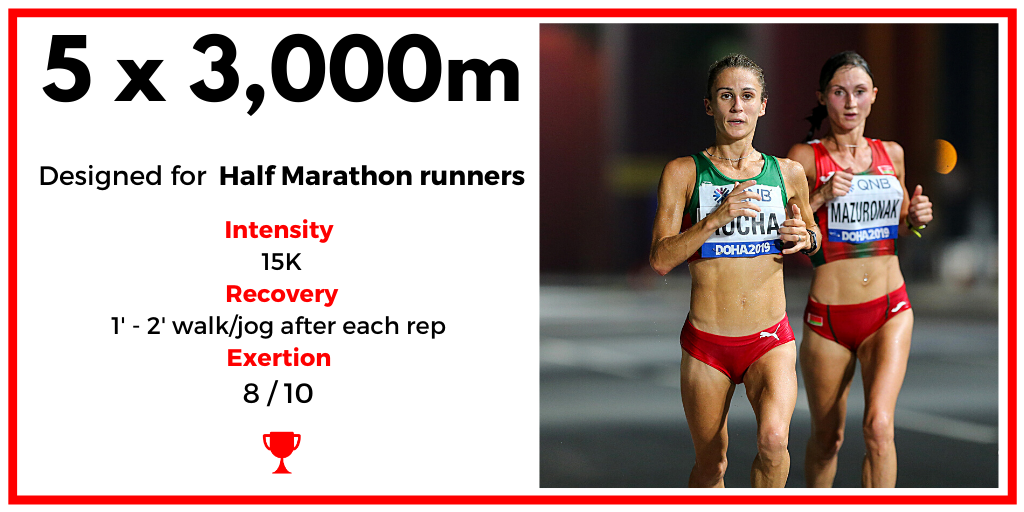Workout of the Day: 5 x 3,000m
5 x 3,000m
Intensity — 15K pace
Recovery — 1 - 2 minutes walk/jog after each rep
Exertion — 8/10
Context & Details
I call 15K pace “threshold” running. I loosely define it as the pace a runner can maintain for about 60 minutes of steady running without excessive slowdown. For many elite runners, there is little difference between 15K pace and half-marathon pace.
The astute reader knows there are actually two types of “thresholds” in the endurance training physiology lexicon, anaerobic and aerobic. Anaerobic Threshold is also called Lactate Threshold (LT) or Maximum Steady State.
This article from Training Peaks outlines concisely the lack of specific clarity surrounding the concept of Lactate Threshold / Anaerobic Threshold / Maximum Steady State. Despite the nondefinitive consensus on LT, the article offers the following working physiological understanding:
What Lactate threshold means is that as muscles get more metabolically stressed there is a higher lactate accumulation and H+. Mitochondria in contractile muscles become more stressed to clear lactate in a timely manner and at some point, if the exercise intensity continues, contractile muscle mitochondria become saturated and therefore cannot keep up with lactate clearance, then exporting it to the blood and this is when we see a rise in blood lactate levels which correspond to the metabolic event when it is not possible to maintain that given exercise intensity.
For me, 15K pace is a runner’s GENERAL or DEFAULT Lactate Threshold / Anaerobic Threshold. If you’ve been a regular reader of Workout of the Days then you’ll know I often reference Lactate-Threshold Velocity as a key performance indicator that training should upgrade. This is different than a runner’s GENERAL LT, or 15K pace. Running velocity at lactate threshold is the velocity above which lactate begins to accumulate in the blood. And the most effective way to teach muscle cells to handle lactate and pyruvate quickly is to expose them to higher concentrations of the two compounds, and that means fast-paced training.
Traditionally, steady-state, LT, or tempos runs at prolonged sub-maximal speeds has been a popular means to attempt to improve the velocity at Lactate-Threshold for 800m runners and up. The idea with tempo runs is to work just below the threshold which lactate begins to accumulate in the blood and extent the duration of those runs.
There is sound reasoning for this approach, such as an increase in Fat Max, or fatty acid fueling substrate utilization, for running at the practiced tempo. But the major limitation with moderate training speeds is that it’s dissimilar from actual racing speeds from the standpoint of neuromuscular control of gain and power. Moderately paced training is not very specific to racing, and this results in difficulty in developing good running economy at race speeds for runners in competitive distances of 13.1 miles and shorter.
Additionally, if you are an elite runner training for races around 13.1 miles and shorter, fat-burning fuel becomes an increasingly minor source of energy at intensities above velocity at Lactate-Threshold. However, I should note, for the marathon, from elite to recreational, fat-burning fuel is extremely important, so traditional sub-maximal LT work is essential.
With all that said, this workout for the 1/2 marathon is focused on advancing running economy, resistance to fatigue, and velocity at Lactate-Threshold. Running 15,000m in 3,000m segments at 15K pace with short breaks is an effective method to teach the brain and body how to handle higher concentrations of lactate and pyruvate. The key to advancing this session is to make the rest interval shorter in time and/or more moderate in velocity.
You don’t need to make the speeds of the 3,000m repeats faster once the runner has achieved a satisfactory pace on them. For example, when a runner is in the final period of training before the target 1/2 marathon race they could perform this session with the rest interval being only 60” run at marathon or half marathon pace. Appropriate manipulation of the rest period will create the conditions of higher sustained lactate concentrations in even highly trained runners.

